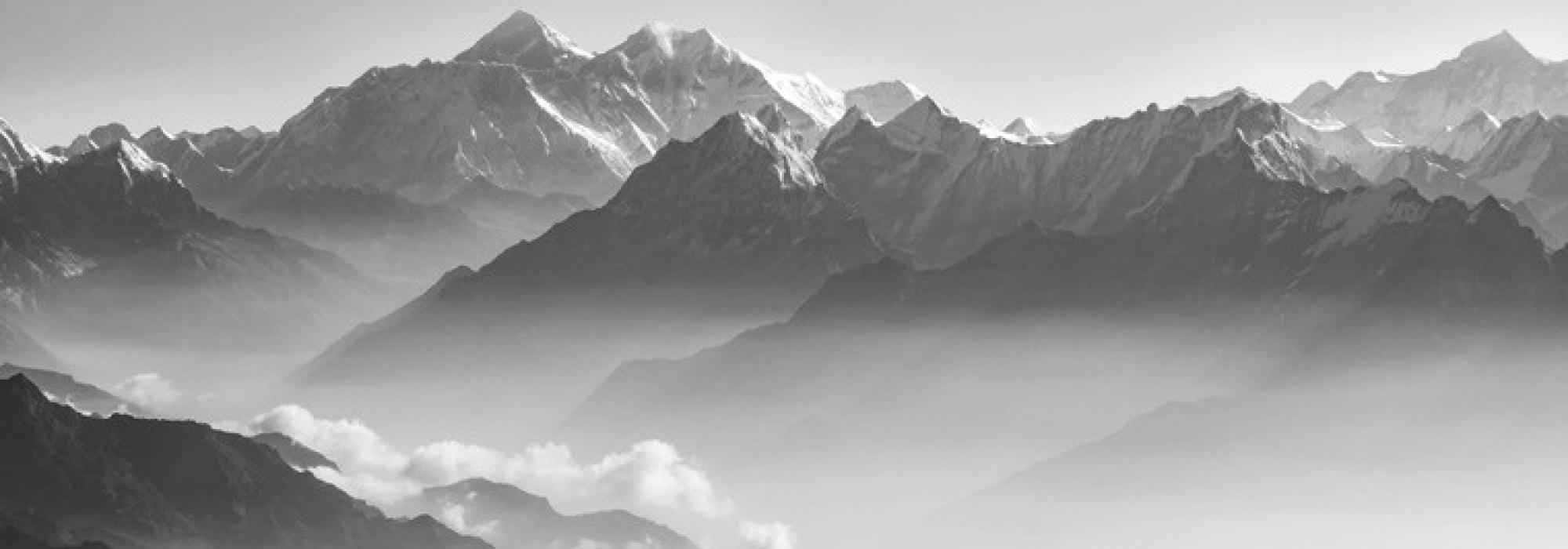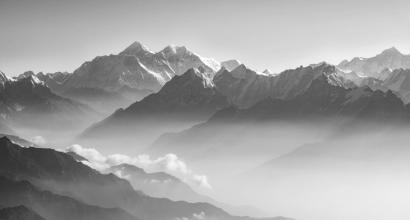itthaṃ rāmāyaṇe dṛśyā gītā-tātparya-mūrtayaḥ ।
īśa-prītyā loka-saṃsthā-kṣemārthaṃ datta-jīvitāḥ ॥11॥The personification of the Gītā’s teachings are thus seen in the Rāmāyaṇa; they surrendered their lives for the love of Īśvara and for the sustenance of the world.
yathā vasante taravaḥ sva-svajātyaiḥ sumaiḥ phalaiḥ ।
śobhante tatvad-evāmī sva-sva-sattva-guṇodgamaiḥ ॥ 12॥Just as trees and creepers look beautiful with their natural flowers and fruit during Spring, the people (in the Rāmāyaṇa) also shine with their natural qualities emanating from them.
vālmīki-vyāsa-kāvyarṣī lakṣya-lakṣaṇa-kārakau ।
īśāvāsyādy-upaniṣat-tattva-sākṣāt-prakāśakau ॥13॥Vālmīki and Vyāsa are both ṛṣis in the world of kāvya. The former portrayed the goals of dharma so that they are directly understandable. The latter has explained the fundamental principles of dharma (in the Gītā). Both of them have clarified the essence of philosophy discussed in upaniṣads such as the Īśāvāsya.
bharatānyvaya-veśma-stha-prajānām-antarātmanaḥ ।
darśanārthaṃ gavākṣe dve cakratus-tau tapodhanau ॥14॥
These two tapasvis have carved out two windows to understand the minds of the successors of Bharata (they are the Rāmāyaṇa and the Mahābhārata).jīyātāṃ sarvadā nṝṇāṃ jīva-sārthakya-dīpike ।
śrī-rāmāyaṇa-kṛṣṇoktir-loka-maṅgala-dāyike ॥15॥
May they always shine, the handlights illuminating the path towards a fulfilled life - Rāmāyaṇa and the Bhagavadgītā, bestowing auspiciousness to the world.Ḍīvījī-saṃjñitaḥ ko’pi brahma-pattana-bhikṣukaḥ ।
cakāredaṃ svamodārtham anugṛhṇantu sajjanāḥ ॥ 16॥
Someone named DVG, a beggar in the city of Brahma, wrote these verses for his own happiness. May good people please view it with favour.
Bhaja Pārthasārathim
Introduction
This song written in the Saṃskṛta language containing the essence of the Bhagavadgītā has been in my book for nearly sixty years. Now it is impossible to know who wrote it, where (s)he was from or when (s)he lived. I had written this down in my book, after listening to it from an elderly person who used to visit our house. His name has slid away from my memory. Those were the days of plenty. There were a few scholars in and around our town who would perform harikathās, recite purāṇas and sing. Many of them were my father’s and grandfather’s friends, and would visit us often. Elderly people like Paṇdita Āvani Rāmasvāmi Śāstri, Rāmacandra Śāstri who was well-versed in purāṇas, Śeṣadāsa, Setumādhavadāsa, Venkatarāma Śāstri who was well-versed in literature, Venkatanārayaṇa Bhaṭṭa, Guḍipalli Nāraṇappa - all of them would stop by and talk to me when they visited our house. When these elders were conversing, occasionally verses, songs or proverbs would turn up. If I hovered over there and some of those verses or songs drifted towards my ears and I found them interesting, I was familiar enough with them to request them to explain it to me further. This song was thus given to me by someone upon my request, long ago. I remember that he said that it was a very old work.
In this book, we have discussed whether the Bhagavadgītā is meant for singing. An answer to that question can be seen in this song. It is clear our ancients thought that the subject of the Gītā is meant to be sung. Don’t both śāstra and kāvya commingle in the Gītā? The path of logic is right for those who think that the Gītā is intellectual and consume it in that way; the path of music is right for those who imbibe the teaching of the Gītā through their hearts. The way of the heart is for ordinary people - it is right for ninety percent of them. This song about the Gītā is for them. In many places of this song, the words from the original work have been used without change. The main objective of this work is towards understanding the literature of the Gītā, therefore music is subordinate to its lyrics. There is no scope for musical embellishment. While pronouncing some letters, musicians should make appropriate changes in the tempo as required. There is no reason to think that the person who stipulated that this kriti was to be sung in the rāga Mohana prohibited other rāgas. The rāga Mohana agrees with the feeling in this song; it is capable of melting hearts quickly. Many earlier saint-composers have composed kritis in Mohana. From my experience of old music, I feel that it was a popular and easy rāga for our ancestors. Since there are thirty stanzas in this song along with pallavi and anupallavi, other rāgas can be aesthetically used and it can be sung as a rāgamālikā. The tempo and music should be convenient for bhakti and dhyāna.
Bhaja Pārthasārathim
bhaja pārtha-sārathim ayi citta śaraṇaṃ ॥ pallavi ॥
tyajānarthāri-ṣaḍvargaṃ viṣayā’ṃśca virasān ॥ anupallavi ॥Worship him, O Mind, the charioteer of Pārtha,
The only refuge, on him you fix.
Get rid of abominable sense objects,
And the enemies six.(Description of Srikṛṣṇa)
sita-rathyāṃś-caturo’pi । caturantaṃ gamayantaṃ ।
dakṣiṇa-kara-vetraṃ । kañjābha-netraṃ ।
vāmapāṇi-khalīnaṃ । sarva-vastuṣu līnaṃ ।
rādhā-hṛdayānandaṃ । saccidānandaṃ ॥ 1 ||In Arjuna’s chariot, nimbly leading the four-sided (earth),
Holding the cane in his right hand, the lotus-eyed,
With the reins in his left hand, pervading all things,
The bliss of Rādhā’s heart, Sacchidānanda.
itara-karoddhṛtāṃbuja-rājāyudha-rājaṃ ।
bhāsita-śrīvatsaṃ pālita-vatsaṃ ॥
līlā-nihata-kaṃsaṃ yogi-mānasa-haṃsaṃ ।
karma-pāśa-lavitraṃ sajjana-mitram ॥ 2 ||Pray to him, who
Shines with a lotus and the king of weapons (the chakra) in his other hands,
Is adorned with the śrīvatsa, protecting calves,
Sportily destroyed Kaṃsa, the swan in yogis’ minds,
A sickle for karma’s noose, the ally of the virtuous.haya-khurotthita-dhūli-dhūsara-mukha-padmam ।
bhāsita tāpiñchaṃ kacadhṛta-piñchaṃ ॥
vaktra-vijita-candraṃ bhakta-kairava-candraṃ ।
lola-kuṇḍala-hāraṃ lajjita-māram ॥ 3 ॥
Pray to him, whose lotus-face is grey with dust from horses’ hooves,
Beautiful as pongamia sprouts, a peacock-feather in his crown.
With a face more beautiful than the Moon, the Moon that blooms devotee-lilies,
With dangling earrings and garlands, putting Manmatha to shame.
aṣṭāpadāṣṭāraṃ rathamapi bahu nīlaṃ ।
nija-kāntyā kalayantaṃ gāḥ pālayantaṃ ॥
sṛṣṭi-sthiti-layaṃ taṃ jagatām ākalayantaṃ ।
upaniṣadāṃ sāraṃ । karuṇā-kūpāraṃ ॥ 4 ॥
Pray to him, who is an ocean of compassion; who makes, with his innate hue,
The eight-wheeled golden chariot very blue.
One who protects cows[1], he, the essence of the Upaniṣads
Creates, sustains and destroys the three worlds.
senayor-ubhayor-madhye saṃsthāpita-rathaṃ ।
svajanasya taṃ pārthaṃ sandarśanārthaṃ ॥
priya pārtha paśyaitān samavetān kurūn sarvān ।
evaṃ san-nigadantaṃ satsuhṛdaṃ taṃ ॥ 5 ॥
Pray to him, who placed the chariot between two armies
To show Pārtha’s relatives to him.
To the friend of the good, to the one who said
“Look at all the Kurus gathered here”.
dṛṣṭvemaṃ svajanaṃ saṃ śocatā vijayena ।
yacchreyasyān-niścitaṃ brūhi tanme ॥
śiṣyās-te’haṃ śādhi māṃ tvāṃ prapannaṃ bho।
rityuktaṃ savinayaṃ vasudeva-tanayam ॥ 6 ॥
Pray to him, who was humbly sought by Arjuna, on seeing
His family and friends, thus despairing and saying
“I am your disciple, To you I am submitting.
Enlighten me, teach me the right thing”
vāmakarastha kaśā-rathya-mukha-rajjuṃ ।
karakṛta cinmudraṃ sarvatobhadraṃ ॥
upadiśantaṃ pārthaṃ śrutyanta-paramārthaṃ।
Gītā-pradātāraṃ jagatāṃ netāraṃ ॥ 7 ॥
Pray to him, who holds the whip and reins in his left hand,
cinmudrā in the other, auspicious all around.
Instructing Pārtha, the object of vedanta
The leader of the universe, the one who gave us the Gītā.
(Beginning of the instruction - the philosophy of the ātmā)aśocyānanvaśocas-tvaṃ prajñābhāṣitaṃ brūṣe ।
rītiṃ tāṃ mayi sādho mākurvasādhoḥ ॥
gatāsūn-agatāsūṃśca paṇḍitā na śocanti ।
ityāha guḍākeśaṃ yo hṛśīkeśam ॥ 8 ॥
“Mourning those who should not be mourned, you speak clever-sounding words.
O good one, do not behave in that wrong way with me.
The wise are not sorry for either the living or the dead. “
Pray to him, Hṛśīkeśa, who said this to Guḍākeśa.
natvevāhaṃ jātu nāsaṃ natvaṃ neme ।
manujeśā vayaṃ sarve bhaviṣyāma eva ॥
ḍehino’smin yathā dehe bālyādikā- ।
vasthās-tathāṅgāptir-atra na muhyet ॥ 9 ॥
I will not be destroyed, neither you, nor these kings;
We shall always exist. Just as body undergoes
States such as childhood, it also moves to other bodies.
The wise are not deluded by this.mātrāsparśāstu he kaunteya śītoṣṇa- ।
sukhaduḥkhadā ete nāśana-śīlāḥ ॥
tāns-titikṣasva yamete na bādhante ।
sama-duḥkha-sukhaṃ dhīraṃ so’mṛtam eti ॥ 10 ॥
O son of Kuntī, these are but momentary afflictions!
Hot and cold, happy and distressing, they are prone to destruction.
Stay serene in their midst. The wise one who is not affected by them,
Equipoised in pleasure or pain, attains true liberation.
nāsato vidyate bhāvo nābhāvo ।
Vidyate sata iti । dṛṣṭo’ntaḥ-prājñaiḥ ॥
āntavanta ime nityasya dehino ।
hanyamāne dehe । na hanyate dehī ॥ 11 ॥
The wise have understood that an unreal thing does not exist,
That a real thing cannot cease to exist, it always is.
The eternal embodied does not perish, even when
The transient body perishes.
acchedyo’yam adāhyo’yam akledyo’śoṣyaś-ca ।
ṇityo dehī dehā naivaṃ svabhāvāḥ ॥
evaṃ viditvainaṃ na śocitum arhasi ।
kaunteyāvehi tattvaṃ prājña eva tvam ॥ 12 ॥
Invincible, inflammable, cannot be wetted or dried.
This is the true nature of the embodied, it’s not the body !
Understanding this, you are not to grieve.
Wise you are, O Kaunteya, know the principle.
To be continued...
The present series is a modern English translation of DVG’s Kendra Sahitya Akademi Award-winning work, Bhagavad-gītā-tātparya or Jīvana-dharma-yoga. The translators wish to express their thanks to Śatāvadhāni R Ganesh for his valuable feedback and to Hari Ravikumar for his astute edits.
Footnotes
[1]Can also mean knowledge or the Vedas











































